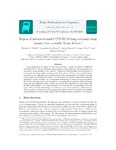Region of interest-bounded COVID-19 lung screening using images from portable X-ray devices

Use this link to cite
http://hdl.handle.net/2183/36788Collections
- Investigación (FIC) [1685]
Metadata
Show full item recordTitle
Region of interest-bounded COVID-19 lung screening using images from portable X-ray devicesDate
2023Citation
Vidal, P. L., de Moura, J., Ramos, L., Novo, J., & Ortega, M. (2023). Region of interest-bounded COVID-19 lung screening using images from portable X-ray devices. In Proceedings of V XoveTIC Conference. XoveTIC (Vol. 14, pp. 111-114). https://doi.org/10.29007/cj6l
Abstract
[Abstract]: X-ray analysis of the lungs was the main method to assess the degree of affliction of SARS-COV-2. Due to the high contagiousness of this pathology, this assessment was conducted using portable X-ray devices. Automatic methodologies were proposed to compensate the image quality of said portable X-ray devices. However, these methodologies were shown to be exploiting external information (such as pacemakers or ventilators present in the images) to determine the severity. For this reason, we present a methodology specially designed to reduce the effect on an automatic methodology of these extraneous artifacts. We extract the lung region and we perform a screening of the presence of the pathology using only the pulmonary region. Finally, to ascertain the performance of the system (and provide explainability to the clinical experts), we generate the corresponding activation maps. The presented methodology has achieved a more than satisfactory performance in all the scenarios and the activation maps clearly indicate that the system is successfully using information from the lung region while excluding elements unrelated to the disease.
Keywords
CAD system
COVID-19
Lung segmentation
Radiography
Screening
X-ray
COVID-19
Lung segmentation
Radiography
Screening
X-ray
Description
Comunicación presentada al V Congreso XoveTIC, organizado por el Centro de Investigación en TIC da Universidade da Coruña (CITIC), os días 5 y 6 de octubre de 2022
Editor version
ISSN
2515-1762





